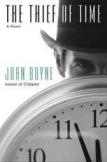Long Live Matthieu
The appeal of stories that explore both time travel and the aging process is obvious enough: characters witness centuries of historical events, cheat death and inevitably question if eternal life is a blessing or a curse. All of this, and more, is present in The Thief of Time by John Boyne, a best-selling Irish writer who has seen three of his novels released in the United States this past year.
First came the young adult novel The Boy in the Striped Pajamas, which explored the Holocaust through the eyes of two children. Then came Crippen, a deft recreation of the notorious 1910 British murder scandal involving Boyne’s titular doctor.
With the century-spanning Thief of Time, Boynewho clearly has an interest in historical eventspresents arguably his most ambitious work yet to American readers. Our guide through Boyne’s centuries is the French-born, 256-year-old Matthieu Zela. I don’t die. I just get older and older and older, he informs readers early on.
The Thief of Time is a learned and at times provocative read. Boyne weaves numerous storylines through the decades, the strongest of which involves Matthieu and his first and only true love, Dominique, with whom he flees strife-torn 18th-century France for England. Boyne’s portrait of life on London’s mean streets is vivid, and Matthieu’s yearning for Dominique is convincing.
At times, however, Matthieu’s other journeys seem of the Forrest Gump variety. He drops in on famous eventsFrance during the Terror, the McCarthy erawhich serve as a backdrop for thwarted romance or struggles with destructive family members.
But Boyne never quite says anything new about the historical era he is exploring. When a relative Matthieu cares for becomes enmeshed in the radicalism of the French Revolution, it is not too difficult to predict his fate.
At the same time, Boyne’s interest in period detail sometimes overshadows Matthieu’s interior life. Also, his prose occasionally lapses into a style more normally reserved for textbooks. There was a gradual shift in the populace from the country to the city, where more and more factories and industrial settings were emerging, he writes at one point.
The Thief of Time has strong moments. Aside from the tortured Matthieu-Dominique love affair, Boyne creates intriguing subplots involving Charlie Chaplin, Herbert Hoover and Pope Pius IX.
The contemporary sections of the book are set in 1999, and explore Mathieu’s life in the dizzying, premillennial world of media, gossip and the broader entertainment industry. The latest in a long line of Matthieu’s doomed relatives is now a drug-addicted television star, while a fellow TV executive has met a shameful death involving drugs and an underage girl. Our era, of course, is one in which celebrity seems central. Boyne’s more astute readers will note that this was the case only somewhat less intensely during Chaplin’s 1920’s and McCarthy’s 1950’s.
Nevertheless, it is troubling to ponder that what the French Terror was to the 1790’s and Pearl Harbor was to the 1940’s, celebrity and media excess may have become for our own era. As tempting as it is to believe this, it could also be that even our most intelligent social observers (Boyne is certainly not the only one) have been drawn into the tawdry vortex, choosing to overlook less sensational but more profound forces shaping our era. That The Thief of Time even raises such questions is a virtue. John Boyne is under 40, and his fiction has already been translated into over 20 languages. Any novelist who presents three historical novels to American readers in a span of 12 months or so deserves attention. Thus far, I would say, Crippen is actually Boyne’s best work. I do not think it is an accident that Crippen is the later work, published in 2004, four years after The Thief of Time was originally published.
Boyne is clearly building an impressive career, improving with each of his diverse works, and leaving American readers with the impression that even better things are coming.
This article also appeared in print, under the headline “Long Live Matthieu,” in the April 30, 2007, issue.








